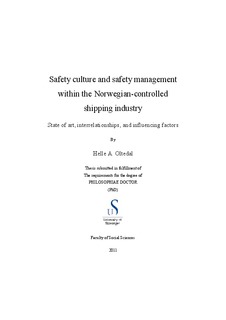Safety culture and safety management within the Norwegian-controlled shipping industry ; State of art, interrelationships, and influencing factors
Doctoral thesis
Permanent lenke
http://hdl.handle.net/11250/184968Utgivelsesdato
2011-10-21Metadata
Vis full innførselSamlinger
- PhD theses (SV-IMS) [19]
Originalversjon
Safety culture and safety management within the Norwegian-controlled shipping industry ; State of art, interrelationships, and influencing factors by Helle Asgjerd Oltedal, Stavanger : University of Stavanger, 2011 (PhD thesis UiS, no. 137)Sammendrag
This research focuses attention on safety challenges within the Norwegian
shipping industry. A status picture of the shipboard safety culture and the
interrelationships with safety management and organizational factors is given.
Three research questions are explored: (1) What characterizes safety culture
and safety management within the shipping industry? (2) What is the
relationship between safety culture and safety performance within the
shipping industry? (3) What characterizes shipping companies’ application of
the safety management concept? In order to explore these research questions,
four aims were defined to guide this work: (1) to outline and discuss the
application of safety culture and safety management within merchant
shipping; (2) to outline and discuss relevant theories of safety culture and
safety management and analyze the relationship between safety culture and
safety management; (3) to support the use of a methodological framework for
the assessment of safety culture in relation to safety management; and (4) to
assess safety culture within merchant shipping and analyze the relationship
with safety management and actual performance. The research questions are
further examined and specified in six journal articles.
The thesis is divided into two main parts. Part I includes the overall
framework in relation to research aims. Part II presents the six journal articles.
In part I, chapter 1, a general introduction and a status picture of risk, safety
management, and safety culture within the shipping industry are presented,
which gives reason for the research aims and questions introduced in the
chapter. Chapter 2 outlines the safety responsibilities within the industry at
the international, national, and company levels. Emphasis is placed on the
vi
International Safety Management (ISM) Code, which provides the minimum
standards and guidelines for operational safety management. Chapter 3
provides theoretical clarification and framing with regard to safety culture and
safety management. This chapter also introduces a general working model
used in the studies of safety culture and safety management in this thesis.
Chapter 4 presents the methodological approach. The thesis builds upon a
mixed method approach where both qualitative and quantitative techniques
are used. The main results are briefly summarized in Chapter 5, followed by a
discussion in Chapter 6 and concluding remarks in Chapter 7. The concluding
remarks concern study limitations, implications, and suggestions for future
research.
The thesis draws upon theory from both the socio-anthropological and
organizational psychological directions. In accordance with the organizational
psychological perspective, a survey was carried out. A safety culture
questionnaire developed by Studio Apertura, a constituent centre of The
Norwegian University of Science and Technology (NTNU), in collaboration
with the Norwegian DNV and the research institution SINTEF was used. In
total, 1,574 questionnaires were distributed to 83 tanker and bulk/dry cargo
carriers, with 1,262 being returned from 76 of the vessels. The vessels were
initially randomly selected from the Norwegian Shipowners’ Association
member list, but as participation was voluntary, some withdrawal occurred.
Statistical analysis involves descriptive statistics, factor analysis, regression
analysis, and structural equation modeling. The statistical survey results were
complemented by qualitative data obtained through document studies, case
studies including two tanker companies and two bulk/dry cargo companies,
vii
interviews, participating observations and field studies at sea, and
participation in other maritime forums.
The study results indicate several deficiencies in all parts of a traditional
safety management system defined as: (1) the reporting and collection of
experience data from the vessel; (2) data processing, summarizing, and
analysis; (3) the development of safety measures; and (4) implementation.
The underreporting of experience data is found to be a problem, resulting in
limitations related to the data-processing process. Regarding the development
of safety measures, it is found that the industry emphasizes the development
of standardized safety measures in the form of procedures and checklists.
Organizational root causes related to company policies (e.g., crewing policy)
is to a lesser degree identified and addressed.
The most prominently identified organizational influential factors are the
shipping companies crewing policy, which includes rotation systems, crew
stability, and contract conditions, and shipboard management. The
companies’ orientation toward local management, which includes leadership
training, educational, and other managerial support, are also essential. The
shore part of the organization is identified as the driving force for
development and change in the shipboard safety culture. Thus, safety
campaigns should to a larger degree include and be directed toward shore
personnel.
